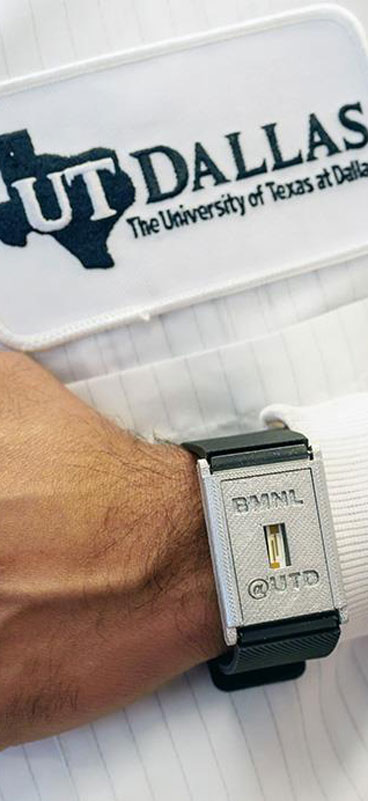

Shalini Prasad, PhD
Career Highlights
Professor
Nature Scientific Reports Paper Among Most-Read Chemistry Papers of the 2017; Fellow of Society for Laboratory Automation and Screening; Developed wearable sensor technology for numerous applications, including wearable technology, environment monitoring, food quality testing, point-of-care and point-of-need diagnosis
Associate Professor
Developed a sensor that could analyze proteins that could distinguish between Alzheimer’s and Parkinson’s disease within a nanometer change of protein structure
Assistant Professor
A company licensed her nanomonitor device that analyzed cardio biomarkers from a drop of blood
Interdisciplinary Researcher, Sensor Platform Innovator Named Head of Bioengineering Department
Dr. Shalini Prasad, an interdisciplinary researcher who specializes in creating early diagnostic sensor platforms affordable enough to impact worldwide health, has been named head of the Department of Bioengineering in the Erik Jonsson School of Engineering and Computer Science.
Prasad, a professor of bioengineering and a Cecil H. and Ida Green Professor in Systems Biology Science, has been serving as interim department head since 2018.
“Shalini is an excellent example of productivity and leadership in both the classroom and in the lab,” said Dr. Stephanie G. Adams, dean of the Jonsson School and holder of the Lars Magnus Ericsson Chair. “That she is a continual learner is evident in the expanding impact of her personal research and growing administrative responsibility. Her example will elevate our faculty higher and I look forward to her empowered leadership, energy and passion as we continue to grow the Jonsson School.”
At nearly 10 years old, the Department of Bioengineering is one of the fastest-growing in the nation, ranking in the top 10 largest undergraduate programs in the country, according to data from American Society for Engineering Education. The department has about 25 faculty members, 630 undergraduate students and 130 graduate students. Prasad first joined the program shortly after its inception and has helped shaped the curriculum.
“UT Dallas promotes the idea of human-centered engineering design – essentially engineering solutions to enhance human health,” said Prasad. “We have received crucial investments of facilities and equipment, and established advantageous partnerships with UT Southwestern Medical Center.
“We are in excellent position for the next 10 years to be a leader of Texas grown, Texas developed innovation with global impact,” said Prasad, also an adjunct associate professor at UT Southwestern.
Her administrative priorities are implementing the recently approved redesign of the undergraduate student curriculum to enhance the bachelor’s degree program in biomedical engineering; providing master’s degree students with more experiences in industry and the regulatory part of engineering health; and continuing to increase awareness about the doctoral program.
After studying engineering in India, Prasad focused on interdisciplinary research while completing her doctorate in electrical engineering at the University of California, Riverside. Members affiliated with her lab have backgrounds in chemistry, mechanical engineering, and materials science, among other areas. Her doctoral work implemented biology on microelectronic circuits – learning how cell communication occurs and how that communication changes when nerve agents are applied.
“Shalini is an excellent example of productivity and leadership in both the classroom and in the lab. That she is a continual learner is evident in the expanding impact of her personal research and growing administrative responsibility. Her example will elevate our faculty higher and I look forward to her empowered leadership, energy and passion as we continue to grow the Jonsson School.”
Dr. Stephanie G. Adams
Jonsson School Dean
Even now, Prasad commonly attends conferences and sits in classes of professors from other disciplines.
“I can speak fluently the languages of biologists, materials scientists, chemists, engineers,” she said. “Success is found when you reinvent your thinking to extend the way you look at a problem. By learning about other disciplines, you can develop certain traits that you can implement into other areas.”
After earning her PhD, Prasad continued the interdisciplinary path while at Portland State University. She also became an adjunct assistant professor at Oregon Health and Science University and researched the design of a sensor that could be used noninvasively to identify harmful plaque in heart arteries.
She expanded her interdisciplinary skills as a content expert in organic/inorganic interfaces at Arizona State University’s National Nanotechnology Infrastructure Network Node, Center of Solid State Electronics. There, she used perspectives of materials scientists, electrical engineers and chemical biologists to research leveraging microscopic, fabrication tools toward designing nanoscale electronic interfaces compatible with organic materials such as blood cells, DNA and other proteins.

She joined the Department of Bioengineering in the Jonsson School in 2011. Since then, she has continued to find success as director of the Biomedical Microdevices and Nanotechnology Laboratory, in which she has advised about 35 doctoral students, more than 55 master’s students and nearly 90 undergraduate students from a variety of academic backgrounds. Her research has been funded by federal agencies such as the National Institutes of Health and industry partners such as Sharp Microelectronics, Intel Corp., Novartis, Texas Instruments Inc. and W.L. Gore and Associates Inc. She has authored or co-author more than 100 peer-reviewed articles, about 15 book chapters, given more than 150 conference presentations and 150 talks. She holds a dozen international and U.S. patents or provisional applications.
Prasad plans to maintain an active lab in which she can continue her innovations. Notably, she has developed a wearable diagnostic tool that measures three diabetes-related compounds – cortisol, glucose and interleukin-6 – in microscopic amounts of perspiration. She has also created novel sensors including a first-of-its kind sensor for real-time measurement of carbon dioxide and relative humidity that may be useful in “Internet of Things” applications such as automobile and smart-phone manufacturing and monitoring of building’s energy efficiency and a sensor that uses saliva to report within one minute a subject’s level of THC, the psychoactive component in marijuana.
Another of Prasad’s goals as department head is to serve as an example and resource for people who may fall outside traditional lines of academic research success: those who did not attend an Ivy League university, who are not male, or who may be a person of color.
“Engineering can be a lonely place, especially for minorities of any sort,” she said. “But I have worked hard and bootstrapped my career, and I believe in paying it forward. The bioengineering department at UT Dallas is a place where the best ideas come to fruition, and together we can apply engineering principles to human health.”

Academic Experience
Education
Bachelor’s degree in electronics and communications engineering from University of Madras, India; PhD in electrical engineering from University of California, Riverside
Research Interests
Biomolecules and their microenvironment within sensors to develop early diagnostic platforms
Appointments
Adjunct assistant professor at Oregon Health Sciences University and assistant professor at Portland State University and research assistant professor and content expert at National Nanotechnology Infrastructure Network Node, Center of Solid State Electronics Research, Arizona State University; associate professor at Wichita State University (H. Russell Bomhoff Endowed Professor of Engineering); adjunct associate professor at UT Southwestern Medical Center and professor and Cecil H. and Ida Green Professor in Systems Biology Science at UT Dallas